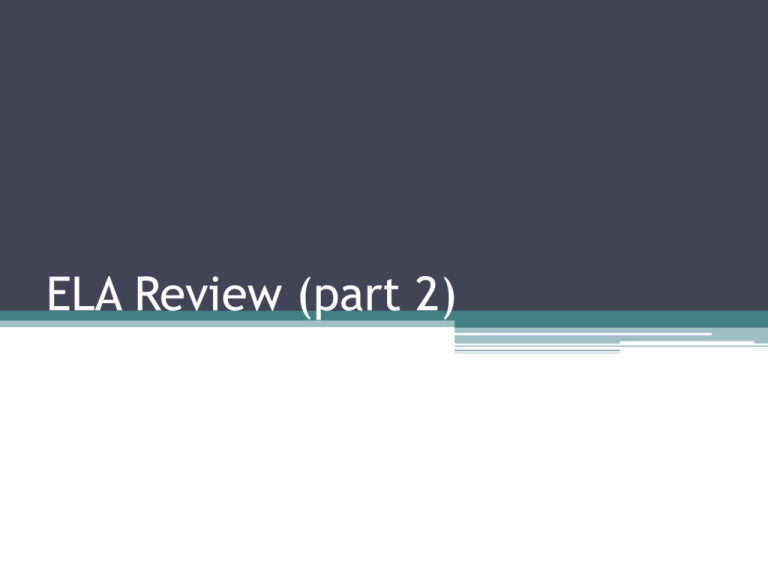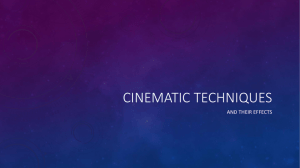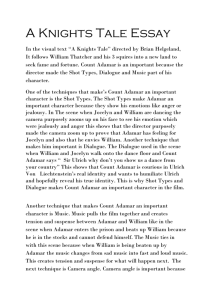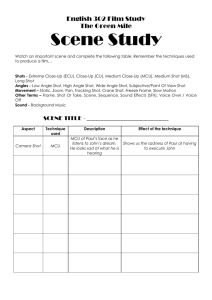1_review_pt2
advertisement

ELA Review (part 2)
Visual Reflection
• Camera Shots
Long shot
Full Shot
Medium Shot
Close Up Shot
• Camera Angles
Bird’s-Eye View
High Angle
Eye-Level
Low Angle
Oblique Angle
Visual Reflection Answers
• Camera Shots Long shot
Full Shot
Medium Shot
Close Up Shot
• Camera Angles
Bird’s-Eye View – picture from above the object
High Angle – picture looks down on the subject
Eye-Level – picture from same level as the observer
Low Angle – picture from below the object
Oblique Angle – picture uses tilted camera frame
•
•
•
•
•
•
•
•
•
•
•
•
•
•
•
•
•
•
•
•
•
•
•
•
•
The Bird's-Eye View is the most disorienting angle to shoot a subject. The camera is placed virtually
on top of the subject looking down towards the subject and the ground. Directors
only use the bird's-eye view when they want to make some kind of dramatic comment on a character or
scene. In Regeneration (Gilles MacKinnon, 1997), a film about the brutality of World War I, an incredible
bird's-eye view shot of the battlefield is used to open the movie. The effect of this shot is to suggest the
madness of war and the brutality it inflicts on soldiers.
The High Angle does not look as disorienting for audiences as the bird's-eye view. Instead it tends to
draw attention to the importance of the environment or setting for a scene. High angle shots also tend to
make characters look small and are often used by directors to symbolically suggest insignificance or
withering authority. A high angle shot positions the camera above eye-level, looking down on the
subject, which consequently appears insignificant.
The Eye-Level shot is the most common angle seen in movies. Scenes are shot at roughly the same
level an observer might see the scene. These shots are not terribly dramatic. Instead, they're used to
photograph scenes that explain story development.
The Low Angle has the opposite effect of a high angle shot. It tends to focus attention on the size and
significance of a character or object. Often directors will use this kind of shot to symbolically announce
the power and authority of one of their characters without literally telling the audience this information.
A low-angle shot has the camera looking
up at the subject, who then appears important, powerful, or domineering, again depending on how
exaggerated the angle is
The Oblique Angle is shot by laterally tilting the camera frame. Anyone who has seen old reruns of the
1960s Batman and Robin television series will be familiar with this kind of shot. In
this case, the effect was to suggest a sense of "crookedness" and anxiety. More recently, television
news shows and music video programs have tended to use oblique angles to suggest a sense of
Playfulness.
Lighting
•
•
•
•
•
•
•
•
•
•
•
•
•
•
•
•
Front light (sunlight) - Most of the scene is well lit and bright sunny days bring out
the colors of a
scene. It provides the most information to the camera by lighting the entire scene.
Natural sunlight may create a realistic or documentary feel in a movie. It tends to add a layer of
"authenticity" to a movie,
as though the story we are watching on screen is a true-life tale.
Side light - is perfect when the artist wants to emphasize texture, dimension,
shapes, or patterns.
Side lighting sculpts a subject, revealing contours and textures.
Lighting a character from below creates a feeling of power and authority. In Citizen
Kane {Orson
Welles, 1 941}, Orson Welles' character, Charles Foster Kane, is often lit in this manner to suggest
the sinister nature of his growing power.
The use of silhouettes creates a feeling of sinister betrayal.
Lighting a character from above creates a "halo" effect, which tends to suggest
beauty or
innocence. Renee Zellweger {Tom Cruise's love interest} is lit this way in a number of scenes in
Jerry Maguire {Cameron Crowe, 1996}. Combined with the soft make-up used on Zellweger, it
tends
to make her look honest, innocent and beautiful.
Backlight - Light that comes from behind the subject may provide the most dramatic
effects. It simplifies a complicated scene by emphasizing the subject, as in a silhouette. This
technique can be used effectively to frame a monster in horror movies.
Suggestions for Persuasive Writing
•
For future exams, you will be required to write a speech or letter. You will be given a situation, an
issue and an audience. You will have to take a position and try to persuade the audience to agree
with you.
•
Create a clear and specific purpose for your writing by directly responding to the task
•
Carefully choose examples from the information given, such as relevant statistics from
a survey or quotations from an article. You may also include examples of your own.
•
Explain how all examples illustrate the purpose of the assignment.
•
Carefully develop your arguments with supporting evidence.
•
Organize your writing in an appropriate order of presentation. Consider the
assignment’s purpose when you choose your method of organization. For example, the
organization of the introductory and closing comments in a letter is different from that of a speech
or an essay.
•
•
•
•
•
Use language that is specific, clear, familiar, respectful, and persuasive. You need to
create polite writing that convinces the reader of the assignment’s purpose. Be careful not
to insult or make negative statements toward your audience. Strive to convince your
audience that your position is credible, instead of only telling that the opposing position is
wrong.
Five Paragraph Essay
• Introduction – (paragraph one) The thesis statement is the last sentence
in the first paragraph. It tells the reader what you plan to prove.
•
Body – (paragraphs two, three and four) These paragraphs build on the
thesis by including examples of factual and statistical information (or
evidence) that supports or reinforces the thesis.
• Conclusion – (paragraph five) This paragraph summarizes the main points
(or arguments) of your essay and re-states the thesis and leaves the reader
with a thought provoking statement.
Review Test
• 25 multiple choice
• Possibly matching




